Text
Better than ever.
Better than ever.
“Coffee has never been better than today”. I’ve heard this phrase being used few times, in talks and competitions. When I heard this phrase being used, I reluctantly agreed, as personally, I would compare the quality of coffees available, the transparency on the farm, the overall experience with coffee to previous years. There were visible improvements, in roasting to extraction of coffees in shops and roasteries, our understanding on what we do vastly increased, such as importance of water and grind distribution. I see movements of roasters roasting lighter, to showcase the characteristic of the coffee’s origin, process or variety. The improvements on our end has in no doubt, increased the quality and quantity of quality beverage being served globally, which is a good thing. On the other hand, when I think about the the quality grown from the farm, yes, there has been improvements on drying, we know African beds are better than patios or guardiolas, carrying our fermentation is better in tiles than concrete, we know paying the pickers by day than amount of cherries picked will improve the amount of ripe cherries being picked and processed.
The improvements that were had over the last 5 years, had massive impact on quality of the greens, but I believe we’ve hit a dilemma. Our knowledge on the process of roasting and brewing has improved considerably, even though its little, we do have grasp on what we can do to maximise positive flavours in the cup. We can argue that we have more coffees scoring 87 or higher compared to 5 years ago, whilst famers knowledge on processing and drying increased linearly with our knowledge on roasting and brewing, one thing that has stalled is communicating feedback back to the farmers. How can a farmer who produced 86 points jump to 88, then 90?
This was a dilemma I faced when I was talking to my good friend and farmer Jorge Raul Raviera, of Finca Santa Rosa in El Salvador. After using his coffee in competition, which I loved, he asked me how he can improve for next year’s production, and I couldn’t really give him any feedback. The only feedback a farmer gets is a stupid coffee scoring system which needs vast improvements, and its a subject of its own, a score of 88, when the cherry has been off the tree barely 2 months does not translate the overall quality and the swings of quality the roasters will experience from 3-9 months off tree, and this doesn’t really tell farmer what he or she should do to improve their score, whilst famers know what type of fertiliser they need to use, they don’t know how it impacts cup quality, and there are probably handful of green buyer around the world who knows how different types of fertilisers will have direct impact on cup quality. Whilst we have good understanding what’s happening in the cup, we cannot relate that to the farm practises and I think this is a huge gap that needs filling.
Current feedback system from the roaster/green buyer isn’t effective as it should be, who contacts their farm, or importer on the changes in quality throughout the usage of that coffee? Should there be a guideline by CQI on how to effectively correspond feedback to farmers, instead of green buyers going to farms and telling famers what they should do, without any clear factual evidence that it would increase their coffee quality? I’ve seen and heard farms benefit from this, and some, unfortunately not so much.
For me, it was an eye opening experience, where my knowledge on roasting and extraction didn’t help Jorge much. Where I do believe coffee quality has gotten better, but if we want to continue saying ‘it has been better than ever’, establishing a language that will benefit both end of the chain needs to be in place.
9 notes
·
View notes
Text
Coffee defect survey results.
I had overwhelming responses to the survey that I carried out couple of weeks ago, thank you everyone who took part!
The fundamental reason why I carried out the survey is because all too often I find that when I taste coffee either at production cupping at work, or just tasting coffee at a cafe, or anywhere around the world, there are differences in opinion about what we taste. I know this is inevitable, no matter how calibrated you are, there isn’t a default palate. But I’m not talking about the positive attributes about coffee, but more on the negatives of the coffee, the defects.
As a production roaster and cup taster, no matter where you are around the world you cup to identify the negative traits in coffee, and try to work out how to iron those negativity down in the cup. What I noticed though, was that after travelling around and cupping with a lot of different people, each individual people had certain defects they were way more sensitive to, and the other way round.
For defects such as potato, it’s quite an obvious defect as it stinks out the whole room, and actually tastes like potato skin in the cup. But there are some defects where you need training, and needs to be exposed to the defect frequently in order for you to pick it up in cupping. From the responses of the survey, which you will see down the bottom, large amount of people have said they can pick phenol up in the cup, but when you actually spike coffees with phenols in them, people find it hard to pick it up unless you tell them that there is phenol in them. I found this fascinating, and wanted to identify which defects were hot and which were not.
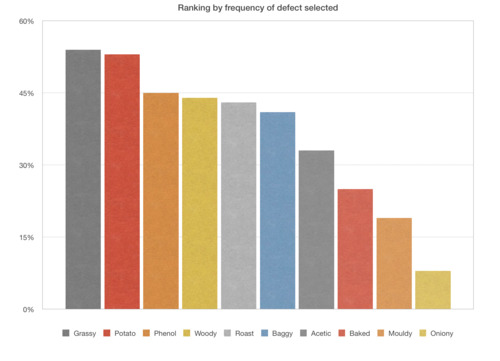
As you can see, you can group the result as 3 separate groups.
Firstly, 54% and 53% of people who took part in the survey selected grassy and potato defect, making these two the most recognisable defect amongst the 10 defects.
Second grouping you can see are 4 defects; phenol, woody, roast and baggy had very close results, as on average 42% of people selected these 4 defects, acetic came in close with 33% of people have said they can identify acetic defect.
Lastly, baked, mouldy and oniony were the defects which had the lowest selection, with oniony only being 8%.
Interestingly, out of all the people who took part, only 3% of people have said they can identify all the defects.
Before the survey results I initially thought potato defect would be over 90%, and defects such as acetic and baggy and grassy would be over 70%, but this is coming from my personal taste, and I find I’m very sensitive to defects such as acetic, baggy and grassy. In my opinion, baked is a strange one, as from my experience, it seems everyone has a very different idea of what baked is, so its a difficult one to agree with everyone what slightly baked coffee tastes like.
With the survey result, it leaves me with one question. Do we have enough tools to calibrate people with identifying defects in coffee? We can argue that potato is easy, but you only get it in Rwandan or Burundi coffees, and they are not around all year. Roast defects are easier to get, but defects such as phenol, mouldy and oniony are not that frequent. If we are to build our sensitivity, we need more exposure, but so far, I believe defects training are quite hard to do, but I believe we can work our way round this with a project I'm involved in which hopefully, will better our defects training.
Watch this space soon.
Mean while, please take part in another survey for me, and I promise you another blog post.
http://goo.gl/forms/3EYcqfKUir
3 notes
·
View notes
Text
Controlling quality control.
As you do with coffee, I've experienced steep learning curve for the past 6 months, so steep I'm still trying to digest, and have a lot more to digest to fully grasp, apply and understand, so this post is just the tip of the ice berg of what I've learnt and can share right now, and I'm still in the process of learning.
I want to talk about Quality control. What is quality control? When you receive a business card and that person is in charge of QC, or you see it on a twitter handle, what does that person do? How do you control quality? I'm not pointing my fingers to anyone, because I carry out QC too, and probably, everyone will have a different methods to carry out QC, and different agenda and reasoning behind what they do. The question of 'what is quality and how do we actually control it' has been hurting my head for some time, if you ask 10 person what quality is, you'll get 10 different answers, but we're all trying to achieve the same thing though, which is consistency in quality.
Before we talk about the QC programmes that are carried out in cafe's or roasters, we need to talk about quality in origin, because that's where the quality starts. I was in Costa Rica few months back, and I was at a exporters office cupping unto 75 coffees in short amount of time, and by using SCAA cupping score sheet, I awarded points and evaluated the samples by tasting them. What I saw myself doing was I was only using the points scale of 7-9, out of 6-10 that was available, and the difference between scores were only like 1 or 2, the difference between lowest and highest was 6.
Coffee that scored 84.5 and 85.5 doesn't seem that different, but it does on price, and when the mass of green adds up, we're talking about considerable amount of money. It's so easy giving 1 more point on SCAA cupping scoresheet, I do partially point the finger on the scoresheet and to us too. We are not a reliable taster, fact. The only few reason why we are okay with tasting is because we give fast response, and we can give qualitative and quantitative information fairly quickly, and we are quite easy to train, and learn how to taste, we pick up things quickly. Our sensory experience can be manipulated so easily, this is something everyone probably knows, but when you research deeper into this, you realise the scores that you give, the descriptors that you give, might actually not be true, and that human to human calibration is actually impossible. Variability and bias can be associated with the cuppers themselves, or the methodology, the coffee it self and of course, the environment. We can never be objective when we are tasting and when we you are tasting your 50th sample in few hours of time frame, you're probably not scoring objectively because you're palate is so fatigued. I'm not being sinister and saying we are useless, but we can be better tasters overall, if we take more precautions when we are cupping, even just palate cleansing and eating flavourless crackers help you so much.
Okay, its something I understand at origin, you have 100's of sample to cup, and score, and that scoresheet has been 'designed' to grade the quality of the green. Then why am I seeing cafe's and roasters using SCAA or COE cupping scoresheet or other scoresheets that has been designed for something specific? Why use them for our QC process? Yes, everyone wants delicious, but every roaster and baristas have different definition on what delicious is, and the approach to achieve that. Then why are we using a meat cleaver as a butter knife? You'd probably get the job done, but you are being super inefficient at it. If you have a specific objective, you need to have the necessary tools that suits what you are trying to achieve. Having a scoresheet or a feedback form that actually fulfils what you want, and what you are looking for, is something we need to think more about, when you really think about your own 'philosophy' of roasting and brewing again, you'll find the scoresheet now you use pretty useless.
In my opinion, you can never control quality, we are the slave to quality until we actually know what we want to achieve, the term quality is so broad, and can be translated into so many meanings, everybody will not agree with you. In addition, we need further training on tasting, specifically, tasting objectively. There needs to be vigorous screening and selection tests to see where your evaluators are sitting at. Slowly, I'm losing my faith in cupping, call me stupid, or what ever, but cupping is a very flawed method to gather proper sensory data. I'm going to carry out few test to prove this, and there will be more on this, but I'm just throwing it out there.
The hardest part, where we find what we want to do, and trying to build something specific for the objective you set. We really need to think twice on the data that we collect, because data is good, but is that data actually useful? And actually, using statistic properly to analyse the data that you obtain, either from roasting or scores from the cupping table to fully interpret and magnify the result you get, and this is the exciting shit right here, when you start to obtain datas that are statistically tested, you can prove something. You reduce the guessing and trial and error. You can be a good taster, and be confident about a theory you might have, but your palate never beats figures. Everything can be better than what you've done yesterday, and to do that, we need the right data, the specific tool to measure what you need to change. We carry out 'quality control' for feed back, so we can roast and brew better and the constant procedure of control and feedback needs to be in loop, and synced. In the long term, we need to able to give useful feedback to the farmers either from the exporter or the roaster, after a year of hard work, I think they would want to hear more than 'you're coffee is tasty', rethinking how we interpret and analyse the data we collect, and using the right tools to do so will I believe have an effect from the farm to the bar.
Valid data -> valuable feed back -> increase in quality.
Even though I'm studying sensory science, rather than obtaining answers, it has given me more questions I can't answer, but I think we should really be thinking about this as an industry. We'll never get the answers unless we tackle it, and we really need to push ourselves to raise the quality.
Oh, and I really don't like the term Quality control any more. What's quality again?
10 notes
·
View notes
Text
No more fines in your 8oz Espro press.
French press isn't my favourite brewing method, one of the biggest reason is the fines that goes through the metal filter which ends up in your cup, giving a tasty coffee,a gritty, sandy mouthfeel and a bitter finish. Then the Espro press came along, and changed the perception on brewing with french press. With their double filtration system, the fine mesh on the double filters does wonderful job removing fines and sediments, hell of a lot more than your average french press, but it doesn't remove 100% of the fines. Now, one way of removing all the fines is filtering it through a paper filter, for example a V60, but it involves having another decanter, alot of faffing about which isn't ideal.
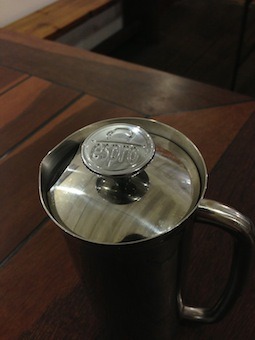
I think I found a way to remove all the fines using a 8oz Espro press, without involving v60 paper filter, with much less work involved. I don't want to say I'm the first person to have found this way, i'm sure there's someone out there who's tried this, I just wanted to share it.
Firstly, you'll need a syphon paper filter.
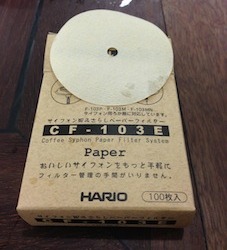
The method is simple, just open the 2 part filters on the espro press, and then place one of the syphon paper filters on the middle of the round filter.

Then place the bottom half of the espro filter on top of the paper filter and push in to the other part of the espro filter, it should fit in nicely.

Now, we need to make sure that the paper filter is secure, we don't it to rip during the plunge. The espro press has a big rubber ring around the plunger, use that to keep the paper neat and secure, like the picture below.
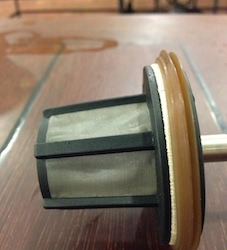
And that's it ! Start brewing as you normally would , take note that when you plunge, it will require more force due to the resistance from the paper filter.
Then enjoy your sediment free cup, and you can remove the paper filter easily after brewing and check how much fines you've removed.


I would love to hear your thoughts!
#coffee#koreanbarista#Sang Ho Park#espro press#removing fines#squaremile coffee#Korean Barista#french press
10 notes
·
View notes
Text
Pucking fresh coffee.
Freshly roasted coffee is good. No complaints there, we don't want to drink stale coffee. But for me, there are times where I need to use a freshly roasted coffee. It sucks even more when its for espresso, for example, for QC, baristas receiving their competition coffee, but its fresh and are itching to taste it, or you only have freshly roasted coffee at home.
It doesn't sound like a dilemma of some sort, but trying to dial in, and pulling great tasting shots; out of super fresh coffee is quite challenging.
There always seems to be a certain flavour that's present when you make an espresso using a fresh coffee, and its quite hard to get rid of. What can you do? Well, you can't force the coffee to degas and settle, and opening a bag or not sealing them to let it degas quicker is a bad idea. When CO2 is released from the porous walls of roasted coffee, so does the many volatile compounds that make up the lovely aromas. Also, adsorption of oxygen and moisture increases the rate of oxidation, thus, 'damaging' the quality of the cup.
With the frustration I had, I wanted to think of a way to use fresh coffee but not by compromising on quality. I think I found a way, but please note that this method isn't suitable for a cafe, needing to go through 5kg of fresh coffee.
All you need is an Aeropress filter.

It seems that when I place a aero press filter on the bottom of the basket, then dose and tamp like you normally would, then extract the coffee, you yield an espresso which is clean and sweet, unlike the harsh, roasty finish you get from freshly roasted coffee.
It seems that the aero press filter removes the bitter qualities in the cup, and what's noticeable is the colour of the crema. Filtered espresso is way lighter, and it seems that the paper filter restrained fines ending up in the cup. Fines and crema tastes awful, by removing these, it seems like the espresso was free from the bitter and roasty aftertaste.
I wanted to know how the filter affect the overall extraction of coffee. So by using the same amount of dose, time, temperature, I pulled 5 shots each of non filtered espresso and filtered espresso, and measured their EXT% and TDS%.
Here are the parameters:
Dose: 17.5g
Time: 28sec
Machine: Synesso Hydra
Temp: 94C
Basket: 20g VST
Coffee: Square Mile RED BRICK Roasted on 28th Jan
Regular espresso shots:

So, except for shot number 3 , they are pretty consistent. They tasted quite nice, fruity with creamy body, but had this bitter, roasty notes on the after taste.
Espresso shots with aero press filter:

It showed that with the aero press filter in the basket, with no change in grind setting or dose, it produces shots with bigger mass. What's more interesting is that, eventhough shots are bigger, and extraction % higher, the TDS% were similar to shots without filters, which pulled shorter shots.
The filtered espresso tasted slightly cleaner, had more complexity and balance. I really don't know why this is happening. I don't know whether the psychological affect of 'This is going to taste better because its filtered' is kicking in and playing with my palate, or the aeropress filter is altering the extraction in some way. It's interesting that, Shot number 3 from regular espresso has 2% difference in TDS compared to a similar shot (in mass) in filtered espresso.
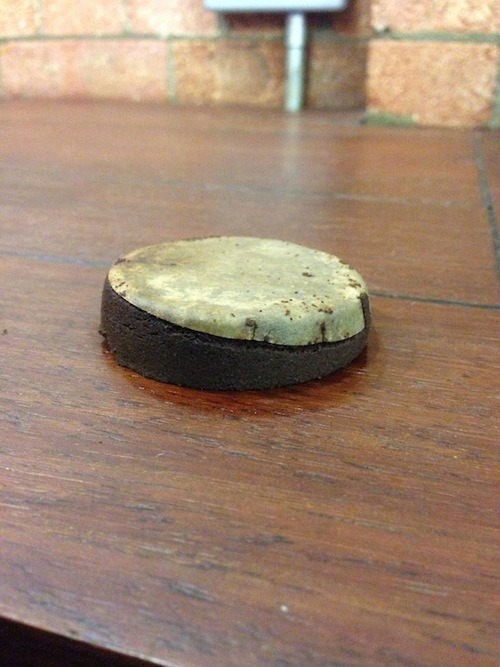
Definite thing is that, visually, the shots pours differently, the filtered shot is much more streaky, and the viscosity of the shot is lower than the normal shots.
5 shots each might not be enough data to justify anything, but,I would love to hear from others what they think!
#koreanbarista#sang ho park#squaremile coffee#espresso#extraction experiment#aeropress#박상호 바리스타#커피 추출#스퀘어 마일 커피
12 notes
·
View notes
Text
Watch your head space.
I've realised that, when I talk about coffee, what I say isn't backed based on a data that's been proven or experienced myself. This frustration has lead me to actually experiment on few things, rather than pondering and hypnotising myself that my pocket science (very little of it) is correct.
One subject that I always wanted to, but had no commitment to experiment, was the importance (if there is any) of headspace between the shower screen of espresso machines and the coffee bed.
In my perfect little world, I always believed that it did, that having some head space produced higher percentage of consistent shots, without any data to back my opinion on. I started to have firm believe because of several reasons, firstly, I got so frustrated when, even though I have the same dose, grind setting, extraction time and temperature of the machine in each shot, sometimes the results fluctuated quite abit. I started to dissect and see what variables I could control and those I couldn't, I didn't even bother about the uncontrollable variables, but I've realised that I've never accounted head space as a variable.
Those of you who use the Nuova Simoneli Aurelia ,would know that each group head has a brass dispersion block. Which disperses the hot water into 8 different holes for even distribution of water from the group head to the coffee bed.
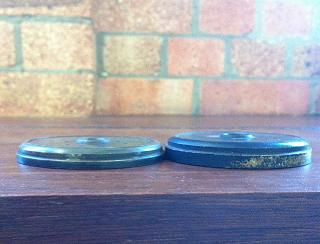
Now this brass block comes in 2 different thickness, 3mm and 5mm ones. I first thought 2mm difference would only make a minute difference but the results below proved me wrong.
To compare and note the difference between the 2 different sizes of the dispersion block, I wanted to gather 2 different sets of data. First being consistency, and second, rate of flow/rate of espresso extraction.
So firstly, consistency:
I wanted to see the consistency of espresso produced in grams, with different size of dispersion block, when other variables become constant. (Impossible but I've tried my best!)
Machine used: Aurelia T3
Temperature: 94C
Time: 28 seconds
Basket: 18g VST
Dose: 19g
Coffee used: Jirmiwachu, Ethiopia SOE
result:
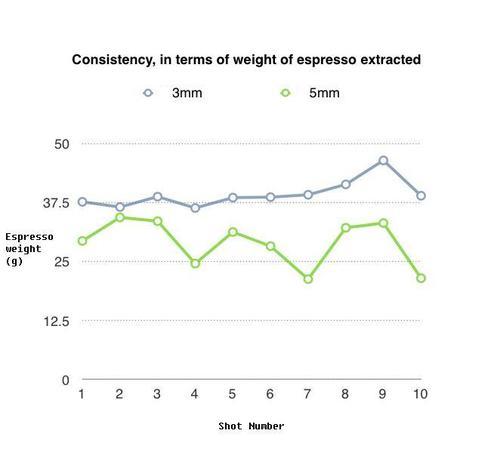
If we ignore the fact that, 3mm block produced big shots that wouldn't normally cut the mark, it is apparent from the data that, 3mm block produces fairly consistent shot in terms of weight , you have to remember that I'm just looking for consistency in weight of espresso produced.
In the other hand, the 5mm block shows that the shots produced are not even, it fluctuates rapidly after shot 4, it produces some values which could be considered as an outlier, and its hard to produce a mean value.
I'm no scientist, and I think people cleverer than me could give me a better answer, but here's an educated guess. If we think of the shower screen as a perfume, and surface of our clothes as the coffee bed, applying perfume from a distance will cover broader surface area of your clothes evenly. On the other hand, spraying your perfume in close range will highly saturate a specific area. If we want the water to be evenly distributed amongst the coffee bed, it makes sense to me to have a gap between the surface of the coffee bed. I mean, we are talking about 93~94C water under 9bars of pressure, 2mm difference in my opinion, gives the water some space to actually distribute the water evenly.

*Note that spent coffee bed from 5mm leaves clear mark of the screw, where 3mm does not.
Lastly, I wanted to record the rate which the espresso was being extracted, by plotting a time/espresso weight graph. The reason why I wanted to obtain this data was to observe the pattern in which the flow of water through coffee bed was affected by the head space.
The result is quite interesting:

Now this graph was plotted using average values from 5 different set of shots, you can see from the result that, 5mm block produces espresso faster than the 3mm block; and that flow is maintained until 17 seconds, where the 3mm block actually overtakes 5mm block and produces more espresso at the end.
Now why does this happen? why does the flow rate gain momentum from 17 seconds on the 3mm block? Here's my guess, the reason why 3mm block took longer to produce any espresso initially, is because the water starts to fill the basket and slowly, and saturates most of the coffee bed before extraction occurs.
Where as the 5mm block (this is just my opinion), the coffee bed is mostly pushed up against the shower screen, and when the extraction occurs, the water isn't able to fully saturate the the coffee bed evenly and finds a path which allows extraction to occur without full saturation.
With my shallow knowledge, I wanted to know why there is an increase in flow from 17 seconds with 3mm block, and I came up with this.
Darcy's law states that, flow rate of fluid increases as pressure increases, until it reaches a certain pressure (correct me if I'm wrong), so it would mean that there are less resistance created by the coffee bed than the 5mm block, allowing the water to flow through the coffee bed at an increasing rate, which means full saturation at the start of the extraction loosens up the coffee bed, and allows the water to flow through evenly, which also benefits even extraction throughout the coffee bed?
I really enjoyed the shots coming out form the 3mm block, not saying the 5mm block didn't produce any good shots, but 3mm block hands down delivered the consistency, and I think we all need that in our lives.
The pocket science rant above could be all wrong, but having the data gives me boost of confidence in what I believe in, and I would love to hear other peoples thought on this. I would also love to be proven wrong, if anyone has better explanation please please comment!!
** For those of you without an Aurelia where you don't have any interchangeable dispersion screen maybe try playing with different basket size, but keeping the dose same.
#Sang Ho Park#Korean Barista#koreanbarista#aurelia#Nuova Simonelli#Aureali T3#dispersion block#london#coffee#barista#squaremile coffee#head space#coffee extraction#extraction experiment
15 notes
·
View notes
Text
How do you Americano
Americano has been on our menu as long as we can remember. Without a doubt, recent push to promote manual filter brewing has caught the customers attention, and more people are becoming aware and open minded of this new way to brew tasty coffee. Still, Americano is a popular choice between customers- specially in recent cold weather conditions. Throughout the day, we(hopefully) check our dose, time and yield and taste countless of shots to see if the coffee is tasting good. Embarrassingly, what I've noticed is that, I invest so much time dialing in filter coffee and espresso, but don't really taste americanos. The excuse maybe that, its too hot to taste and its not tasty, but being a drink which is quite popular, bringing money to the till, I think I or We have been turning blind eye on this drink. Some people say if you weigh every shot, including americano, it should be fine. I know some shops who does that, I'm not saying I never weigh my shots for americano but what I found is that, with our coffee- Type of coffee Dose(g) Time(s) Yield(g) Espresso 17g 29s 31g Americano 18g 31s 33g Tasted the best, a 31g of shot of espresso which tasted good itself, can't give you the same satisfying result when you further add 4oz of hot water or steamed milk, there should be different recipe for different types of drink. When I tasted the americano with the shots which tasted good as espresso, It was very watery and just acidic, I know these results vary hugely on the coffee the shops use but even tasting Americanos from other shops, I know there are room for improvements. I just wanted to share this to ask if any of you guys have a different method for pulling espressos for americanos, even though It's a drink which gets no attention in the specialty industry, I want to make sure the 70~80 people who buys americanos from our shop gets the same tasty drink, and more attention from us making their drink as much as the espressos we pull. Comments are welcome
#Americano#sang ho park#barista#coffee#london#koreanbarista#korean barista#espresso#hasbean#squaremile#박상호#런던 바리스타#아메리카노#Black coffee#sang ho
11 notes
·
View notes
Text
Tasty stale coffee.
One of the many joys working in the coffee industry, is trying endless amount of different coffees, in season being offered. For a year, I was subscribed to weekly and monthly coffee subscription from 2 of my favorite roastery. I've learnt so much by tasting different coffees itself, but what I was left with was countless amount of bags of half finished or even some unopened bags. I’m sure we all had this, but I want to focus on our customers, who buy these freshly roasted coffees from our shops.
Recently there has been substantial interest in manual filter brewing method from the customers, and beans have been flying off the shelves. If the beans were roasted on 1st of February, if FedEX does there jobs properly, it could be on the shop shelves on the 3rd of February. Now, we say that coffees taste the best when its ‘fresh’, where generally it is between 2nd day of roasting to 14th day of roasting. Now, I’m not saying it will suddenly taste horrible after 14 days, it will have so much factors affecting this, such as type of coffee, level of roast and also storage. Don’t we all agree that you can drink milk 2~3 days after its best before by dates if they are refrigerated well? Same goes for eggs and many other product.
So customers have generally, 10~12days window to enjoy their coffee whilst its fresh, if its a 250g bag thats around 21g~ 25g of coffee being consumed every day to enjoy them whilst its fresh. Presonally, if you don’t drink coffee every morning, I reckon you won’t be able to finish the bag in time, or you’ll get another subscription coffee and the old coffees are long forgotten.
So, people spend an average of £6 to £13 on bags of coffee, and most likely, they will have around 100g~150g of coffee still in the bag after 2~3 weeks, so what do you do with them? Well, there are lots of things on internet like using old coffees to use as compost, leaving them in fridge and even face pack! I wanted to find out if there are any guide lines, outlining what they can do to make decent cup of coffee using beans over 3 weeks old, rather than throwing it away. Even on the coffee bags, it states, ‘enjoy within 4weeks of roast’. So should people use the same method of brewing for all those 4 weeks? Should they be put off brewing with coffee 3 weeks or 4 weeks old?
-This isn’t a definitive guide to brew good coffee using old coffee, I firmly believe in using fresh coffee will deliver the best result in the cup!
- I will outline the changes you make to your recipe using old coffee from using fresh.
- its an experiment, and I’m not saying it will work for every coffee, as I’ve said before, there are lots of variables to take on board. - If anyone finds something other than what I state below, please comment!
- PLEASE remember, I’m NOT saying you can make the same QUALITY as fresh coffee but something you can enjoy without spitting them out, and actually drinking it rather than putting them in your fridge or your face.
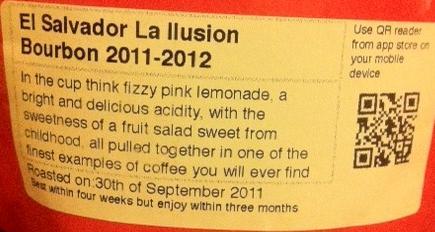
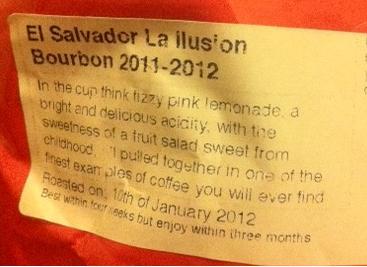
So I wanted to experiment with a coffee I was familiar to, so I chose El Salvador Finca La Illusion roasted by Has Bean, because its on our shops brew menu as well as the espresso, so I know this coffee pretty well. Also luckily, I had an unopened bag of La Illusion which is 5 month old, one which is 4 weeks old and one which is 3 days old. So, I will brew these coffees, with extact amount of dose and water, time and temperature may vary. After brewing, tasting them and mojoing them, then make several changes to find that spot where the old coffees can produce ‘acceptable’ cup.
Firstly, I cupped these 3 coffees, and rated them with scale of 0~10, within different categories.
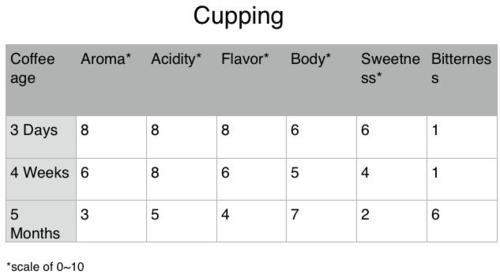
You can see from the cupping scores that 5month old coffee didn't do so well, expected really, but surprisingly had the best body from those 3 coffees.
What really surprised me was, how pleasant 4 weeks old coffee tasted like, the only major difference between 3 day roast coffee was lack in overall complexity, but in terms of acidity, it was bright and lively.
So, I decided to brew these coffees as V60 pourover, I know I can't brew these coffees consistently, but I tried to keep everything the same and mojo the result which is below.

The result showed that with same dose, water, similar time and technique, as the beans that I used got older, more I extracted from the coffee. This has a correlation to the perceived bitterness I tasted from the cupping result.
With this result, I decided that it wasn't really worth experimenting further with 5 month old beans, as they didn't really taste good as V60, very stale, boring and bitter. These were worth going into the fridge and faces.
However, 4 weeks old coffee looked promising, it was bright, some sweetness with nice light body but had unpleasant bitterness coming through. Lacked in the complexity, exciting acidity, sweetness and the body compared to 3days old roast, but I wanted to change how I brewed the 4 weeks old roast to make it taste better and acceptable.
So this is what I've changed.

So, the dose was increased by 1g (6.25% increase from original dose) and amount of water reduced by 15g( 6.25% decrease from original dose).
Surprisingly, using the 6.25% increase and decrease method, When I slightly underextracted the brew, I've made myself a cup of coffee which was substantially better than one I made before, ok, it still wasn't good as 3 days old roast, but there was increase in that sparkling acidity and complexity, though sweetness and body was still missing- it was an acceptable cup.
I would be interested to see if anyone experiments with 6.25% increase and decrease method I used with different coffee and brewing method, using old coffees to see if they get a positive result like me.
I know for the experienced coffee professionals, you guys don't have to read this blog to figure out how to brew decent cup with stale coffee, again, this post is to help(hopefully) home brewers and having fun and learning myself. And please don't think I'm weird telling people to try stale coffee, but If you can make yourself a half decent cup of coffee when you have no fresh coffee at home; using 4~6weeks old coffee, and doing some experiments and having fun whilst doing so, I don't see why people should be trying it.
In this industry, you learn so much by tasting, tasting is believing!
Comments are welcome!
#Sang Ho Park#Korean Barista#koreanbarista#stale coffee#coffee stale#tasty stale coffee#whole beans#old beans#coffee#experiments#extraction experiment#extraction#barista#london#hasbean#drip coffee#v60#hario v60#making tasty coffee with stale coffee#Pourover#sang ho park barista#mojo to go#Filter Coffee#박상호#박상호 바리스타#드립 커피#오래된 원두
8 notes
·
View notes
Text
Just add water. Not.
One thing that confused me before coming to Korea, is the method of extraction using Kono or Hario drip(V60) method. Every single video I saw, no on used scales or timers. So since coming to Korea, I've drank aloooot of manual drip filter coffees.
I'm writing this post because I'm at a point where it kind of annoys me(personally) after finding out how they extract coffee. It is the method of 'Just add water'.
Back in London, the coffee to water ratio varies between 60~65g/Litre, this is my personal preference. So, for 1 cup brew, I used 15grams of coffee and 240g of water and extraction time of 2:15sec and I do stir.
In Seoul, I'm seeing baristas weighing coffees with spoon, which is supposed to be 7g per scoop, using alot of coffee for one extraction and no timer or scales being used.
The weird thing is at the end, they add water to the coffee and dilute it heavily, and Korean people(not all but some) are calling this the 'Korean style'.
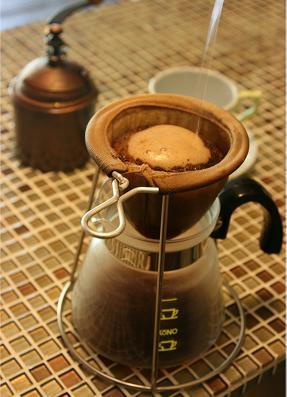

I've asked several baristas the ratios they use, the most used method was this:
Coffee: 25~30g
Water: 150g
Time: Unknow
Grind: Very coarse(Near french press)
Water temp: 85~90C
So, with that method, the brew ratio becomes 183.33g/Litre, this is way out of charts, though people say we shouldn't rely on 50 year old data, the method above doesn't really make sense. The end product you get out of it is dark, syrupy, heavily underextracted brew, so what do they do to it?
They add around 100g of water to it and dilute it, and it tastes like watery vitamin drink.
It's like, you extract a ristretto and add some water and call it double shot espresso. Yes, it might be the same weight as a double shot of espresso but it isn't the same drink because double shot of espresso and diluted espresso is made differently. Double shot of espresso(if extracted correctly) tastes good because it has the balance between the sour and the bitter. First part of extraction is very sour because there are much more soluble solids present than water. Extraction occuring at the end is very watery and bitter. Balance between these produces a drink which is not sour nor bitter. If you add water to ristretto, yes, you will resuced the TDS% but EXT% won't change.
Let me emphasis again, majority of coffee I've drank was Kenyan or COE coffees. So why do this to these coffees? Majority of answers I got was
1. Because they don't like the bitter aftertaste
2. Because Kenyan and COE coffees have delicate and bright acidity, thus extraction should be cut when the coffee has reached it peak in terms of acidity, then dilute it to loosen the flavor.
3. Cup of Excellence coffees have very clean aftertaste with nice acidity, so to express that in the cup, they cut the extraction in the first minute and dilute it to make it taste 'Clean'.

I have no right as a coffee person to tell people its wrong, If they think its how it should be done, ok its fair, they've bought the greens and roasted and extracted it. But I just think they should look at other variables which affect the quality, flavor,sweetness,aroma,acidity, bitterness and balance of the cup.
Yes, Kenyan coffees have lovely acidity so do COE coffees, coffee people love acidity, and are very sensitive about bitterness. They should be going backwards to seek out the problem why coffee tastes bitter and bland, not seeking ways to emphasis the acidity by underextracting and diluting it.
Such as:
1. Roast profile, isit roasted correctly? Isit too dark ?
2. Method of extraction, can the barista justify why he/she is extracting that way, experimenting with different method? Do you use scales? Timers?
3. Crop, isit a past crop? Is the green too old? Can you check what the year of the crop is?
4. Grind setting and burrs, isit time to change the burrs? is the grind setting correct? Isit time to clean the burrs?
5. Water, isit filtered well? Have you check the ppm of the water you are using?
I know I sound like a little child winging at what other people do, but honestly, it really doesn't taste good, nd people are paying alot of money to drink it.
It is painful to watch all these good beans being diluted down, without showing its full potential in the cup, I really do hope people start to experiment with brew ratio, brew method and new roast file and let the beans speak for it self, not that first syrupy, underextracted liquid added to water.
Just add water?
Food for thought.
#Sang Ho Park#koreanbarista#Korean Barista#korean coffee scene#coffee shops in seoul#Kenyan coffee#london#Cup of Excellence#pourover#chemex#woodneck#coffee tasting#extraction#roasting#korean roasters#drip coffee#커피#한국커피#박상호 바리스타#박상호#런던 바리스타#코리안 바리스타#한국 드립커피#융드립#고노 필터커피#한국 드립커피 실체#바리스타#런던
4 notes
·
View notes
Text
Korean coffee scene in my own words. Part I
I've been always curious about the coffee scene in Korea, since starting and working with coffee, I never had the opportunity to visit as a Barista. One way for me to learn about the culture was through Aaron's website http://frshgrnd.com/ and through WBC footages, where Korea did well over the past 3 years.
Though my reason visiting this time isn't about coffee, I've tried to make most out of time whilst I'm here. Thankfully, many people were willing to help me out, taking me to coffee shop touring, and also running around myself; trying to analyse and figure out the difference, similarities and things I can learn from.
(This post is strictly my oppionion, based on what I've seen, hear and taste so far)
One thing that surprised me was that, Korean people don't drink coffee in the morning, coffee shops are quite empty until 3pm and gets mega busy from 4pm, back in London, alot of coffees are made in the morning, many people drink coffee to wake up, that seems not to be the case in here. In Seoul, coffee is something you drink when you meet people or after a meal.
In addition, things I've found weird is that, for an average lunch/dinner you are expected to pay £3 in Seoul, but price of a medium latte can vary between £3~3.5
In Seoul, in most cases, coffees are more expensive than food, yet, people are filling up the spaces and they are full till late at night.
There are so much coffee shops in Korea, I was gob smacked by the sheer number alone. In London, Oxford street, I would guess that there would be no more than 15 coffee shops or less; in Seoul, street similar size as Oxford street, 34 exist, majority of them are chains.
Plethora of independent shops exist, much more than London, one distinctive common similarities between these shops exist. Around 70% roast their own, on site. This seems appealing and in some angle very cool, roasting your own coffee, making your own blend. The problem is that, over 80% of these people learnt roasting by reading books, and had no coffee related back ground, I know this because their inexperience and lack of knowledge manifested in the cup massively.
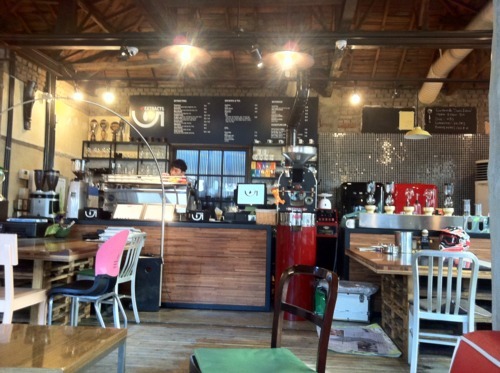
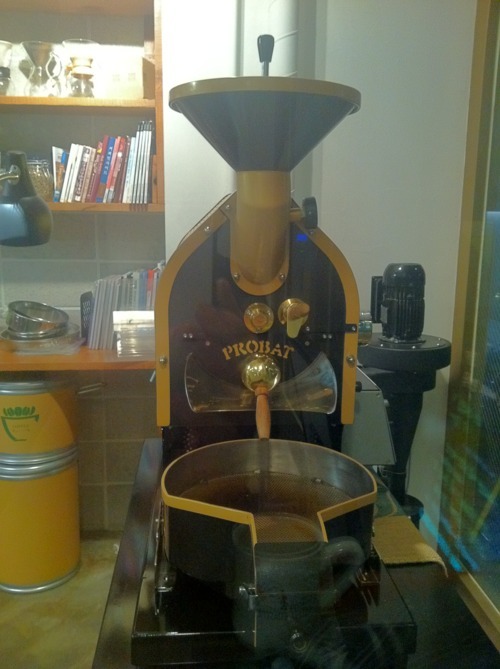
Also, they place the roaster in the shop fronts, next to the windows. Korea is very humid, also temperature fluctuates massively throughout the day, with these condition, roaster should be kept down stairs or in a place where temperatures are more stable, these guys are placing roaster as part of a design, not for any other reason, it was pretty disappointing to see them selling the product for that ridiculous price to the customers.
Korean people are very 'space' orientated, we like to have big personal space, thus the design of the cafe changes. Cafe's are noticeably bigger, with seat and table, nice lay out of the bar, good use of colour, light wood, many accessories, wi-fi and with air conditioner students take these space, tucked away in the corner, drinking coffee and studying or reading a book. In my oppinion, in London, the culture of drinking coffee is much more of; drink promptly or take away, it was quite surprising for me to see that, it is other way round in Seoul.

I've also noticed the highlight and over exaggeration of Cup of Excellence coffees around cafes in Seoul. I do agree that Cup of Excellence coffees are delicious, and they are pricey for a reason, as it shows the fact that the farmer have invested tremendous amount of time and effort to produce what he/she have harvested. But I disagree at the fact that Cup of Excellence coffees are 'God's coffee' as described by a Cafe in Seoul, and also the fact that they can charge their customer twice the price when it is poorly roasted, and also poorly extracted. It makes me angry when I see this happening, the farmers have put all the effort and the roasters and baristas ruin it at the end and still charge customers £6~8 pounds per cup. I would be happy to pay the above price if that quality can be proven in the cup, but so far I've been disappointed with COE coffees in Korea, there should be more emphasis on microlot coffees, there are amazing microlot coffees being produced and they are not COE, they are cheaper than COE, which means you don't have to bend your back to buy the green beans; and customers don't have to feel uncomfortable paying ridiculous price.
This shows the Auction result of Cup of Excellence Costa Rica 2011, top 3 lots are bought from Korea, Japan and Taiwan.
Not every people are like that in Korea, there are roasters and baristas trying to raise the bar to a higher standard. For example the coffees I've tasted in Coffee Libre in Seoul is so far, the best coffee I've tasted, they try to Direct trade with farmers, roast to a higher standard and most importantly, listening to customers and trying to match their needs. La caffe also, the owner, Mr Bang, has huge interests in machine tuning and machine maintenance, I've seen some of his amazing works and was gob smacked.
I'm hoping that I find more people like them in Korea, though I havn't finished my time in Korea, I hope that when I write the post for Part II, I can write more positive things and write about things I've learnt.
(Part II coming soon)
#Sang Ho Park#korea#Korean Barista#coffee#coffee tasting#coffee libre#seoul#korean#london#la caffe#roaster#cup of excellence#COE
15 notes
·
View notes
Text
Nose temperature.
One of many things I love about coffee is the fact that, the flavors of coffee that can be discerned changes as it cools. So when we are served a pour over or a syphon, we wait until its quite cool. However, recently I've been wondering about our nose, I find the nose really interesting, because as nose contributes significant amount to what we taste; most of the time, what we smell will taste like it. For example when we drink a cup of coffee with our nose blocked, all we can feel in our mouth is the body of the coffee, not the flavor, so no nose, no taste.
So we know that coffee tastes better when its cool, but then when can we smell coffee better?
I decided to have an experiment- to see the difference when our nose is at different temperature, and how it affects how we smell things.
This is what I did:
1. Brew syphon of Costa Rican Santa Lucia from Square Mile, and separate them into 2 tumbler glass( The reason I chose the tumbler glass is because I was able to discern more flavors of coffee, more than latte glass or porcelain cups.)

2. Just as they are decanted into 2 glasses, I go out side and start to inhale the cold air (It was 3 degrees celcius) for 1 minute so the temperature of the nose gets lower.
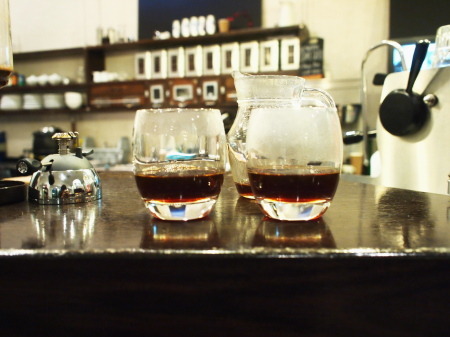
3. I come back in and straight away, swirl and smell one of the tumbler glass, then taste.
4. Then drink a glass of sparkling water, inhale the warm air indside(set for 27 degrees celcisus) for another minute.
5. Quickly smell the remaining tumbler and taste.
Because the experiment seemed not fair, in a sense that; I had to leave another tumbler 1 minute longer, I repeated the experiment but then did it other way round (Inhaling warm air first then the cold one).
The result was quite surprising, for me anyway,that when my nose temperature was lower, the aroma was much more defined and vivid than the aroma I could discern when my nose was warmer. I felt that, when I was inhaling at warmer condition, aroma felt muddy and as if something have diluted the aroma.
This started to make me think how roasters roast beans in their roastry, if they have a set temperature when they roast or cup the coffee, as one might roast the coffee and cup them in a quite humid, warm environment, they might not pick up the aroma they sought after.
Furthermore, how this affects baristas who lives in hot and humid countries, how their nose is adapted to smell in those conditions, and if they will notice the difference when smelling between summer and winter- if their country have high temp fluctuation at summer and winter.
Feedback would be nice to see if my nose was completely wrong and I should go and check in the hospital, or if any of you guys experienced same things as me!
My educated guess will be that, humdity or warmer air contains less oxygen but more particles( like dust) which blocks the receptors in the nose, which distrups our smell.
Who nose :) ?
#nose temp#nose#barista#Sang Ho Park#coffee#smelling#cupping#syphon#coffee tasting#coffee smelling#korean#Taylor St Baristas
4 notes
·
View notes
Text
Looking after customers and ourselves.
We, as a barista take care of our customers. From start to finish, we try to look after our customers, we try to deliver our promise to make them nice coffee.
We go into much details such as cleaning the basket, dosing, thinking about extraction yield, weighing our shots and so on.. we look after customers behind the machine without them realising, but are we looking after ourselves?
This week, I've been working around people who were quite ill, coughing and sneezing. I get very annoyed the fact they still come into work with the state they are in, they say they 'have to work for the money'. In my opinion, that is being selfish, they don't realise they might infect other people, and most importantly; they don't realise customers are watching.
Customers do not look how our shot comes out, but they do look around our surroundings, such as hygiene and cleanliness.
Here is a example:
1. Customer pays for the coffee
2. Barista sneezes into his/her hands
3.Barista manual doses the grounds
4.Barista touches the portafilter handle and starts extraction
5.Few minutes later another barista pulls shots with same portafilter.
From that example above, i would say at least 2 people may have got infected.
Manual dosing when you have just sneezed onto your hands is just wrong. Some people might say the heat from the water will kill the bacteria, it might be true, but that is not important when the customer saw you sneezing, saw you not washing your hands and started to make their coffee. Would they come back?
In addition, when your hands are full of bacteria and you touch the portafilter handle, from that moment every single person who touches that handle will have same bacteria on their hands.
We want to deliver excellent service but sometimes we forget about the most simplest, yet most important things. If you must come into work when you're ill, at least wear a mask, otherwise have a day or two off, don't abuse your body.
Her are few things where we can do to prevent bacterias spreading, and most importantly things we can do to respect our customers.
-Buy quick dry antibacterial hand gel, so you don't have to go back and forth washing and drying your hands.
-Sanitise portafilter handle (with anti bacterial wipe/spray) before other baristas start to use the machine.
-Eat lots of fruits, try to avoid caffeine consumption(or too much)
-Always remember that customers are watching you; even though you think they are not, you are on show, spotlight is always on you.
I know this might be a obvious post for some of you reading, but i see so many people forgetting about these simple things in cafes and restaurants, i had to point it out.
Making good coffee≠best customer service in the world, look back at what you do, start to think more about hygiene if you are alread not.
It's always good to make nice coffees to our customers, but we should also look after ourselves and customers differently, not coffee wise.
3 notes
·
View notes
Text
Teflon coated....(Long post)
Plethora of things are teflon coated these days. It's on the frying pan, fabrics and recently it has been sprayed on our portafilters. It was a mission to clean the dirty dried up remains of an espresso shots, and we can't clean our baskets and portafilters after every shot pulled. After coating the surface with teflon, only thing i do now is rinse with hot water, nothing else.
Then i came across this:
http://www.jimseven.com/2010/09/28/teflon-coated-baskets/
James Hoffmann did an interesting experiment with teflon coated baskets, with a video.( Check that post first before reading on this post if you haven't done so)
I thought by coating the basket with teflon; flow rate and extraction from coffee bed would remain the same, or would have correlation to non teflon coated basket.
I was wrong; the teflon somehow changed all things where i thought it would remain unchanged, and the video shows that.
This made me thought 'Teflon coated portafilter is enough', until this showed up

Yes, it is a teflon coated dispersion block for Nuova Simonelli Aurelia. This was sent to Andrew by Paul from Coffeehit (Many thanks Paul) for us to play with and test on. So on a quiet Saturday evening, i made my way to Bank, where i got to play with this little green thing 1 on 1.
My first impression was 'just a dispersion block with teflon' nothing special really, except for the fact that; on the hand, it felt really smooth and silky, unlike the rough brass dispersion block.
Side by side, it looks like this
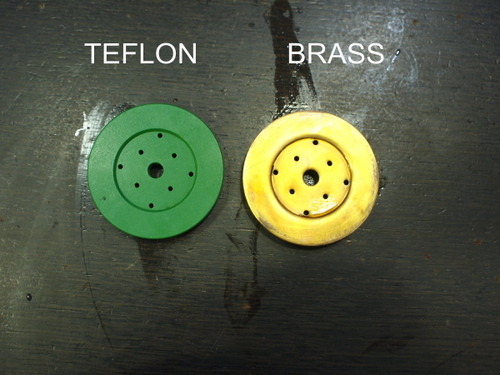
For those who does not know the function of the dispersion block on the Aurelia, put simply, hot water is jetted out from the mixing cavity at an angle; this is done so when it hits the dispersion block, equal amount of water by passes the 8 holes on the block itself, so water is distributed evenly, hence achieving good extractions from all areas of the coffee bed.
I thought having teflon on dispersion block is a good idea, as it is very very hard to clean! So i quickly fitted the teflon block on one of the group head, and started to pull some shots through and start my experiments..
Experiment 1.
Firstly, i set the grinder using our house blend, through the group head with no teflon dispersion block. When i started to get good shots through, i measured the dose, time of extraction and the brew weight on both group heads ( one with teflon one without)
So have a look below:


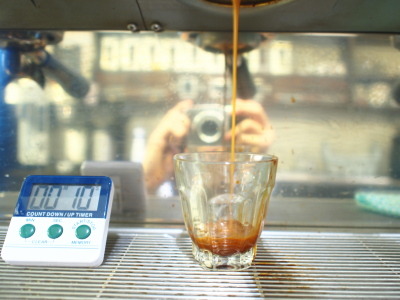

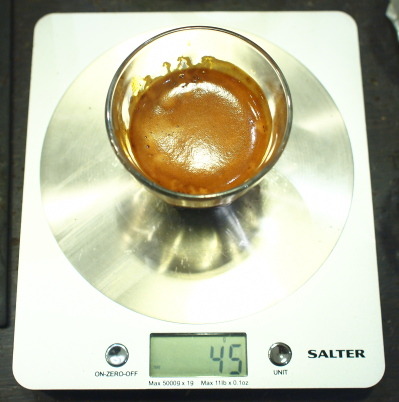
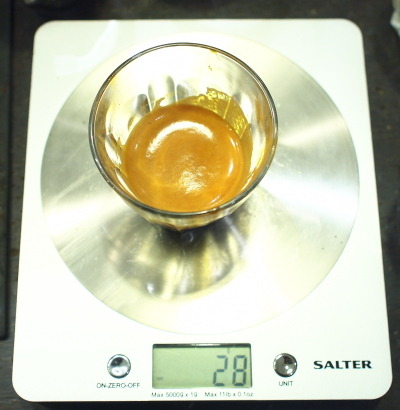
So for each shot, i tried to get these variables constant:
Dose : 21g
Time: 25sec
Tamping technique
Few things that i want to point out, or you guys already noticed is that, the teflon shots were pulled from a naked portafilter, where as brass had spouted portafilters, also, i can't guarantee that each group head was at equal temperature, but i would imagine that it was within ± 0.5℃.
Even with these factors did contributed to the fact that; my experiment was not entirely 'Uniform' or 'Accurate' giving fair results, the results did surprise me.
17g difference in brew weight is quite big. Very big i would say. Also, when i was observing the shots coming through the group with teflon, it seemed to me that the water was not removing much soluble solids from the coffee bed, to me, it seemed to be channeling rapidly even though the shot was aligned at the centre,
here is a picture:

With my eyes only, i couldn't explain what was happening, so i decided to let my palates take charge. The shot from the brass dispersion block tasted of everything i desired; floral notes along with apricot notes coming through, giving way to sweet chocolate notes finished with very nutty after taste lingering in my mouth.
On the other hand, the shot from the teflon dispersion block was quite unpleasant.
It felt to me as if i was drinking sour americano, flavors were underdeveloped, it was very watery in my mouth, so much dilution, i could only taste slight nutty notes on that shot.
After tasting each shot, I've realised that, somehow, the teflon dispersion block was not doing it's job. It wasn't letting water pass through the 8 holes equally, or evenly so even extraction could happen, instead channeling was occurring, not much of the water was going through the coffee bed removing soluble solids.
I had no clue why this was happening, i repeated the same experiment over 10 times but i had the same results as above.
Experiment 2
I decided to take a look on the spent coffee bed. What this tells me is how much soluble solids have been readily removed from the coffee bed. So if i pulled; nice evenly extracted espresso, the spent coffee bed should have nice graduation of color. The top of the coffee bed( where it has first contact with water) should be lighter than the bottom, and inside the coffee bed, should have nice color distribution( Light to dark from top to bottom).
Here are some pictures of the spent coffee bed:

The spent coffee bed from teflon is still quite dark, where as coffee bed from the brass is noticeably lighter, showing that soluble solids has been removed from the top of the bed.
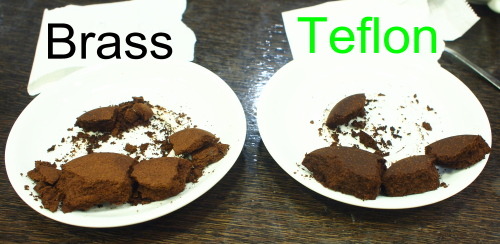
From the second picture, i wanted to show the color inside the coffee bed, this picture, just like the first shows that the coffee bed from the teflon is still dark, no change in colour between coffee bed, not much solids were removed.
I don't know, I just don't. I know that teflon dispersion block causes or contributes majorly to channeling, therefore producing under extracted, sour shots. But i just can't figure out why...
If i was to take an educated guess, i might say that; maybe there is something to do with friction of the dispersion block. Brass, even though on hand it feels smooth, on microscopic view of the surface will be very rough looking, so causing friction when water is flowing on it's surface.
But if we cover that surface with teflon, are we taking away all that friction or most of it? Making the surface 'slippery' for the water?
I don't know, i guess it's up to the scientist for this one... it was enjoyable though, in the mean time, i will make sure i give these brass friends nice polish.
Comments and suggestions are welcome!! I would like to hear what other people think about this alot!
Sang ho
1 note
·
View note
Text
From Korea, with love.
As a Barista, i think communication is a vital skill. Not only between customers but with other Baristas. This can also be translated to networking, knowing other Baristas will lets you experience and learn other areas unexplored by ones self.
The reason i have mentioned this is because, i myself have gained many benifits from networking with other Baristas in London and around the world.
Recently, i had the chance to trade coffee(Square mile for Jong Hoon's coffee) with my other fellow Korean Barista: Jong Hoon Lee. Many of you might already know him. He was one of finalist in WBC 2009, he has proven to the world of his talents and recently has decided to open a espresso bar in Seoul, Korea.
Jong Hoon roasts his own beans, making his own blend for espresso and cappucino, he does not hold back on the components used in his blends, he uses cup of excellence coffees as his components which is rare in Korea. Korean cafes tend to go for average quality beans to produce one of many mediocre blends.
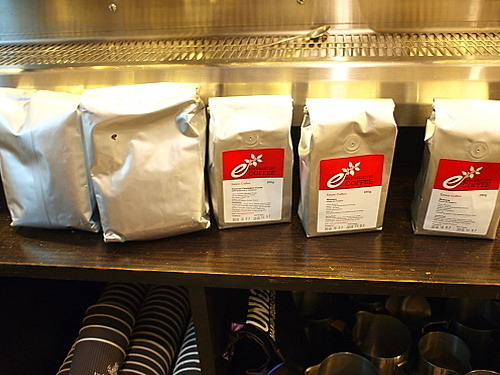
Today at work( Taylor st Baristas, Bank site) , i dialled in the espresso blend Jong hoon sent over which arrived 2 days ago. The components of the blend are just below:
40% Brazil Fazenda Passagem Funda COE 2009 # 7
Variety: Catuai
Process: Pulped natural
50% Guatemala Alfonso Anzueto - Isnul COE 2009 # 13
Variety: Pacamara
Process: Sun and dryer
10% Kenya AA Peaberry Mchana Estate
Variety: Bourbon
Process: Fully washed and sun dried
As you can see it consists of 3 different types of beans. Honestly i thought it would be the same old case where, Brazilians giving body and sweetness, Guatemalans with balanced sweet acidity and Kenyan for the extra fruit and juciness. I was wrong( always the case) big time, this espresso blend was like no other. It was explosive in the mouth, gentle on the nose and so smooth and juicy on the pallates. I could taste and feel how much time and effort Jong hoon had put in. I was able to taste the love.

The blend was dialled in using a Synesso Hydra, this is what i did:
Dose: 20~21g
Temp: 95 C
Pre-infusion: Yes, 5 sec
Extraction time: 23 sec excluding P.I
Brew weight: 30g
Extraction yield: 66%
Aroma notes: Lemon tea with honey
Taste notes: Pleasent bright acidity upfront, notes of blood orange and red berries, hint of white grapes. Gives way to muscovado sugars and sweet chocolate finish, hint of 'Terry's chocolate orange' aftertaste.
Body and mouth feel: Extreamly juicy and light body with almost silky, refreshing mouthfeel
It tasted brilliantly, everyone liked it, every single person told me how much they have enjoyed it. Also i decided that,all the money from selling espresso from this blend was going towards the charity 'Coffee kids'. It was pleasing to see people enjoying the coffee and doing good deeds towards the coffee industry.
I'm sure i'm not the only one networking with other Baristas oversea, i just wanted to tell you guys the benifit of having a blend from another country, sure UK has excellent choice of beans to chose from, but as a Barista, we should teach our customers about coffees outside of UK and how it differs between them, and learn how we can improve what we already have.
It was an honor having Jong Hoon's blend in the hopper today, and i'm sure it won't be the last. I also think Jong Hoon should get lots of credit for what he does in the Korean specialty coffee industry, he has improved the quality of coffee in Korea vastly, i believe. I'm sure his start on improving the quality, rather than quantity will act as a catalyst among the specialty coffee industry, and will continue further more.
Well done Barista Jong Hoon Lee, well done Republic of coffee.
Once again Jong Hoon, thank you for the lovely coffees from Korea, with love.
#Jong Hoon Lee#Republic of coffee#Korea republic#Sang ho Park#Korean#Korean Barista#Taylor St Baristas
3 notes
·
View notes
Text
The past 6 month of my Barista life
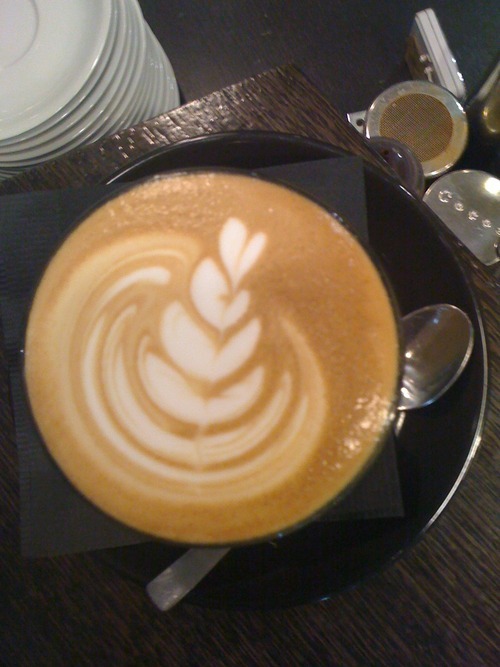
I was ordinary. I was just another countless kid from far east Asia, from Korea to be exact, dreaming of success on foreign soil. A victim you could say, of a culture where it demanded you to study study study and have a nose bleed, become a doctor, lawyer or an engineer and make your parents happy; so they can talk about you to their freinds how successful i am.
For the past 12 Years i pursued something where, i couldn't confidently say 'I can do this all my life'. Until i came across coffee. Strictly it's my 6th month of becoming a serious Barista, 6th month from where, i decided coffee will become part of my life and i will dedicate my time to coffee all my life.
It has been a roller coaster ride (for me anyway) for the past 6 month, i have seen and experienced many things and most importantly met great people along the way and learnt incredible amounts of knowledge from these people.
I decided to write this post to take a step back; and see how far i came since 6 month ago, and how little i came until the point where i want to be. I just wanted to highlight the moments and people i have met, which changed the course of my Barista life and thank them for moulding me into what i am right now.
London School of Coffee, The espresso room and Ben Townsend
At late March this year, i decided to take the VRQ Barista skill course in LSC. At that time i had no experience of using a tamper, did not know where coffee originated from and i thought you can extract coffee upto 35 sec. With my little skill on latte art, thats where i met Ben Townsend, i didn't know anything about Ben, his backgrounds, his shop, practically everything. Ben amazed me every single day of that short 3 days course, i was dazed to be hit with so much interesting, yet challenging information about coffee, Ben changed me within 3 days of that course, i still remember when i had to serve Ben series of drinks and how nervous i was.
Luckily i passed both practical and theory exams and gained a merit, and i really wanted to learn more and more about coffee and asked Ben for a job, i still remember how desperate i was. I thought obviously, Ben will say no, he had the right to as i was so inexperienced, but Ben told me to come to his shop 2weeks later, and started my work at The espresso room.
I learnt so much when i worked with Ben at the shop, all my foundation was built up from which Ben has taught me, such as 'Time to lean,time to clean', Ben isn't a ordinary employer, he is a teacher and a freind, he made me settle quickly in a foreign environment, made my mind open up more and every moment was a joy.
If it wasn't for Ben, i wouldn't be here writing this right now, it has been some time last time i worked for Ben, i always seem to miss him when i have the chance to see him, i miss The espresso room and i should make a visit real soon and work there once in a while. I have said this to Ben before but i will say it again, I love you Ben, you are a great inspiration!
Taylor St Baristas, Andrew, Nick and Laura Tolley
I remember meeting this bloke with a bike helmet and a jacket in The espresso room. Ben told me to make a shot of espresso for this guy and Ben introduced me to him, telling me he is one the Tolley's who owns Taylor st Baristas, it was Nick.
I thought that would be it, but 1 month later i got a call from Ben in the afternoon telling me to call Laura of Taylor st and meet her for a interview, i did that and few hours later i was at the Bank site, it was a struggle to find but i made it. I thought it would be an intense 30 min interview talking about coffee and myself, i remember taking a printed material about coffee and reading it until just i got into the shop and trying to memorise them. But it wasn't a interview i thought of, there wasn't any geeky questions about machines and origin of coffee, me and Laura just sat down and had a flat white, i remember telling Laura ' I just want to learn more and become better'.
After a nice relaxing chat, i was introduced to the staff, it was a complete different enviornment to The espresso room, the shop was big and very very busy, it was a new challenge for me, i realised 2 things. First it is going to be physically demanding to keep up with masses of order, second i had to maintain the quality of the coffee in a busy environment. With new challenge set, i thought i would do well honestly, but things were much different. I couldn't keep up with the orders and i was so exhausted, in addition, i was also slightly intimidated as i was the only person with black hair, brown eyes and absence of OZ accent,and another great shock was that my knowledge on coffee was still paper thin, it fustrated me and motivated me to research more about coffee, study it and share things i learn with other people.
I didn't meet Andrew until much later on after i started to work at Taylor st, i remember asking him if one of his brother taught at London school of Coffee, when it was actually Andrew who did. every time i worked with Andrew, he taught me great deals on coffee and skills. I found that Andrew and Ben had a similarity, they were both perfectionists. I learnt alot from Andrew just by watching him work, he is a great mentor, Andrew constantly feeds me with knowledge and news about coffee, he challenges the Baristas and his geekiness is praised among the staff, so much so that it is my mission to talk about coffee the most geekiest way with Andrew for atleast 30 minutes.
Without the help of Laura, Nick and Andrew, i would have given up after few days of work, i wouldn't have fit in to Taylor St if the staff wasn't welcoming and caring.
I feel really lucky to have met great people like Ben, Laura, Nick and Andrew in short space of time, and working for them is always a pleasure. This 6 month went past in a flash, i'm looking forward to the road ahead of me, the challenges i will face and people i will meet and learn from.
I thank everyone who has made me into a Barista i am right now.
It is a long post...and boring one also.. i promise next time, i will write a post where you guys can read at least half of it before you fall alseep.
p.s sorry if i have mis spelt any word with crap punctuation, i should go back to studying english.
#Andrew Tolley#Barista#Ben townsend#Korean#Korean Barista#London#Taylor st Baristas#The espresso room#coffee#Sang Ho Park
4 notes
·
View notes